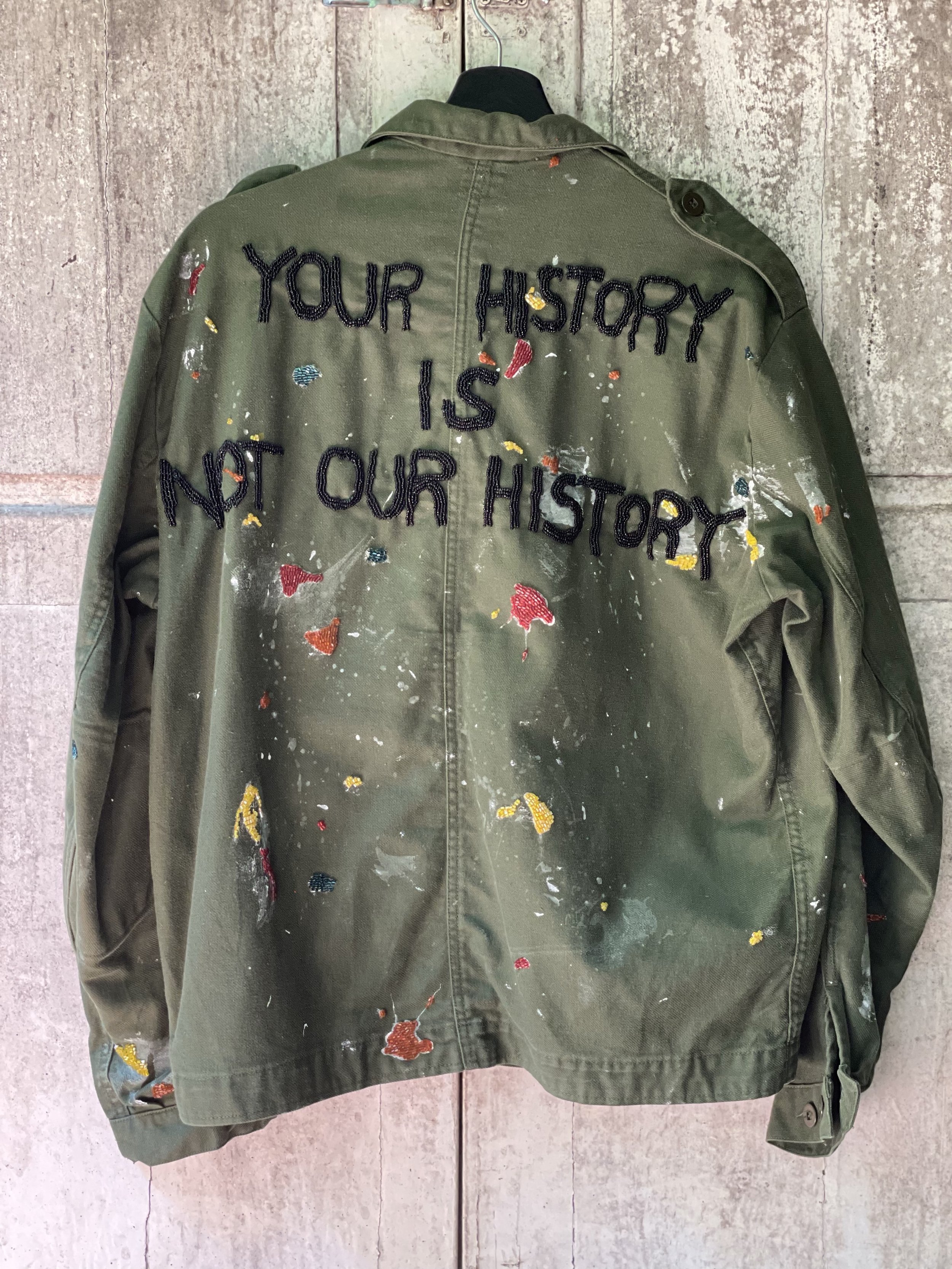Phayao-a-Porter by Jakkai Siributr
Sawang Sawai Siwilai and Art Basel Hong Kong 2022
By Nadya Wang
Thai artist Thaiwijit Puengkasemsomboon sporting ‘Paolo’ jacket while walking his dog.
In 2021 in the midst of the Covid-19 pandemic, Jakkai Siributr launched ‘Phayao-a-Porter’, producing one-of-a-kind, personalised jackets with intricate appliqué designs that feature dense beading and bold embroidered threading to transform pre-used garments into personalised, precious textiles that remain wearable.
The project first occupied his studio assistants and eventually expanded to include artisans in the Phayao province in Northern Thailand as a way to help them keep their livelihoods. 30% of the proceeds from sales are used for scholarships, healthcare and emergency funding for the community.
Recently, through Phayao-a-Porter, Jakkai collaborated with Siwilai Store in Bangkok for the Sawang Sawai Siwilai exhibition, organised by three galleries: ARTIST+RUN, Gallery VER and Bangkok CityCity Gallery. It featured the work of 16 Thai artists, including Rirkrit Tiravanija, Thaiwijit Puangkasemsomboon, Mit Jai Inn, Korakrit Arunanondchai, Haritorn Akarapat, Eiji Sumi, Sutthirat Supaparinya, Nutdanai Jitbunjong, Alisa Chunchue, Harit Srikhao, Nuttapon Sawasdee, and Saroot Supasuthivech. Jakkai produced a corresponding number of limited-edition summer shirts that captured the essence of their work.
For Art Basel Hong Kong 2022, Jakkai will be showing eight hand-embroidered jackets in an online viewing room with Flowers Gallery. In this interview, we ask Jakkai about the seeds of the project, his thoughts on its critical and commercial popularity, as well as future plans for ‘Phayao-a-Porter’.
Installation view of Phayao-a-Porter x Siwilai, a part of the Sawang Sawai Siwilai exhibition.
How did the collaboration with Siwilai for Sawang Sawai Siwilai come about, and how do these summer shirts develop or deviate from the jackets that started off the Phayao-a-Porter project?
The Siwilai Store owner had previously commissioned a jacket from my Phayao-a-Porter project and was interested in collaborating further for the Sawang Sawai Siwilai exhibition by commissioning my team to create 16 limited summer shirts inspired by the works of the sixteen artists included in the show.
I agreed to this collaboration immediately because it seemed like a great opportunity for this project to have my bespoke garments showcased in a renowned concept store along with other unique international brands. The concept of the project remains the same in that one off garments are created. No two are the same.
I launched Phayao-a-Porter, a socially distant embroidery project in January 2021 as a way to keep my full-time studio assistants busy during the 2020 lockdown and later expanded to the artisans in the remote northern province of Phayao when Covid restrictions started to ease. Phayao was chosen because a former student of mine ran a social enterprise from there and had a vast network of artisans. When the pandemic hit and my student had to close down her business, many of the women who worked for her became unemployed. I wanted to help these women by giving them temporarily employment and on top of that, 30% from the sales of each garment returns to the wider community as scholarships, welfare and emergency funds.
The summer shirts are each given the name of an artist. Could you talk about how you have designed each one after the artist who inspired it? How did you interpret their work onto these clothes?
The design for each garment is inspired by the artworks which range from paintings, sculptures, videos and installations. I asked Siwilai’s graphic design team to do the first interpretation as well as the motifs layout and then I reinterpreted their initial interpretations. The graphic design team is able to translate the artwork into very neat and very graphic two dimensional design but they may not be aware of the artisans’ capacity and technicality of hand embroidery. On some garments, I strictly follow their design while on others I really altered the original interpretation where I felt the designs are too rigid and too clean. My interpretation as an artist allows the garments to feel “handmade” and at the same time contemporary and edgy.
‘Your History Is Not Our History’, glass and plastic beads on a paint splattered vintage military jacket.
“Freedom Cannot Be Simulated” – this is embroidered on all the shirts. What does this line mean to you?
This line is derived from the work of the artist Rirkrit Tiravanija and is the central theme for the exhibit. It is also one of the two design requirements along with the Siwilai logo that each garment must have. It was originally designed by the graphic team to be written in a particular font in white on all of the shirts similar to the text that appears on Rirkirt’s work. I chose not to follow the original design because visually, I wanted to incorporate these words into the design of each garment more naturally.
I believe the line ‘Freedom Cannot Be Simulated’ reflects the current political moods in this country and in many other places around the world.
The shirts were all sold out! What are your thoughts about their popularity?
The shirts were all sold out within the first week after it’s launched. And I think their popularity stemmed from the fact that they are limited wearable art inspired by an artist work of art. From its conception, I never intended for Phayao-a-Porter to be just another fashion line but rather an art project that is community based and contributes to society. And credit must be given to the Siwilai team. Together with their experience in retail and my artistic eye, we were able to collaborate on art pieces that have great commercial appeal.
‘Burn Baby Burn’, Glass and plastic beads on a vintage French worker jacket. Photographer: Pokchat Worasub
How do you work together with your artisans to finish these clothes, and what does their participation give to you in the collaborative process that you enjoy/cherish?
Normally the initial design and embroidery start here in my Bangkok studio by me and my assistants. When each piece is worked on to a certain point and shows enough guidelines, it is sent to the artisans in Phayao to be completed. But it became complicated while working on these Siwilai pieces during this current wave of Covid. If someone in their village becomes sick, local authorities will seal off the village thus making it impossible for anyone to enter or to leave. So these garments had been shipped back and forth between Bangkok and Phayao more than necessary. I believe each individual has a unique hand and embroidery style so I’m not particular about how each person embroiders a motifs. Their individual hands are allowed to show on each garment under specific guidelines to meet quality control.
“I believe each individual has a unique hand and embroidery style so I’m not particular about how each person embroiders a motifs. Their individual hands are allowed to show on each garment under specific guidelines to meet quality control.”
Between designing clothes to be worn and creating artworks to be hung, is there one you favour to the other, or if this is not a good question to answer, what does each endeavour give to you that the other does not?
Phayao-a-Porter allows me to delve briefly into my childhood fantasy of working as a designer in the fashion industry since my background is in textiles design. I know I would not be able to survive in the industry that relies greatly on outside factors as far as production is concerned. That is why even with this project, I still treat it as a conceptual art project by creating one-of-a-kind pieces. The difference between creating artworks to be hung and making clothes is that I create the garment according to my client’s specifications.
A Phayao artisan working on a jacket commissioned by Thai-Australian artist Vipoo Srivilasa.
A Phayao artisan working on a jacket commissioned by writer and historian Pimpraphai Bisalputra.
How will the project be shown within the Online Viewing Rooms at Art Basel Hong Kong in May?
For the upcoming Online Viewing Rooms at Art Basel Hong Kong in May, I’ll be showcasing eight existing hand embroidered jackets as well as offering limited commissions.
What is coming up next for Phayao-a-Porter?
When this project was launched, it was intended to be a limited series but I have decided to continue since the pandemic doesn’t seem to be going away anytime soon and many people are still facing economic difficulties. After Art Basel Hong Kong, I’ll still take on bespoke commissions and there could be more collaborations with other brands in the near future but I don’t have any intention of expanding the project into a real fashion business.
“I have always stayed true to the textiles medium because from the beginning of my career, I saw an endless possibility of what this most domestic technique can bring and I will continue to challenge myself working with a needle and thread.”
‘Blind Faith II’, 2022. Brass Buddhist amulets and glass beads on a Thai military uniform. Photographer: Chanupat Boonwong
Could you talk about your participation in the exhibition ‘Garmenting: Costume as Contemporary Art’ at the Museum of Arts and Design with the works ‘Blind Faith I’ and Blind Faith II’ (2020). What does it mean to you to be a part of this exhibition, and how do you intend to continue your work at the intersection of activism and garmenting?
When I was a graduate student in Philadelphia, I would take a bus into New York City on the weekends to visit galleries and museums. One of the museums I visited often was the Craft Museum which has since moved to its current location on Columbus Circle and renamed the Museum of Arts and Design.
It is a dream of mine to exhibit my work there and to be included in the exhibition ‘Garmenting: Costume as Contemporary Art’ along with artists I have long admired is considered a major achievement in my 20 year career as an artist. Being able to do what I love and receive the recognition for it, I consider myself very fortunate. I have always stayed true to the textiles medium because from the beginning of my career, I saw an endless possibility of what this most domestic technique can bring and I will continue to challenge myself working with a needle and thread.

















